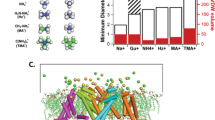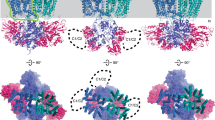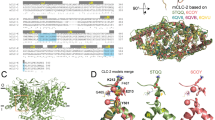Abstract
The molecular forces that drive structural transitions between the open and closed states of channels and transporters are not well understood. The gate of the OmpA channel is formed by the central Glu52-Arg138 salt bridge, which can open to form alternate ion pairs with Lys82 and Glu128. To gain deeper insight into the channel-opening mechanism, we measured interaction energies between the relevant side chains by double-mutant cycle analysis and correlated these with the channel activities of corresponding point mutants. The closed central salt bridge has a strong interaction energy of −5.6 kcal mol−1, which can be broken by forming the open-state salt bridge Glu52-Lys82 (ΔΔGInter = −3.5 kcal mol−1) and a weak interaction between Arg138 and Glu128 (ΔΔGInter = −0.6 kcal mol−1). A covalent disulfide bond in place of the central salt bridge completely blocks the channel. Growth assays indicate that this gating mechanism could physiologically contribute to the osmoprotection of Escherichia coli cells from environmental stress.
This is a preview of subscription content, access via your institution
Access options
Subscribe to this journal
Receive 12 print issues and online access
$259.00 per year
only $21.58 per issue
Buy this article
- Purchase on Springer Link
- Instant access to full article PDF
Prices may be subject to local taxes which are calculated during checkout







Similar content being viewed by others
Accession codes
References
Perutz, M.F. Electrostatic effects in proteins. Science 201, 1187–1191 (1978).
Lee, L.P. & Tidor, B. Barstar is electrostatically optimized for tight binding to barnase. Nat. Struct. Biol. 8, 73–76 (2001).
Waldburger, C.D., Schildbach, J.F. & Sauer, R.T. Are buried salt bridges important for protein stability and conformational specificity? Nat. Struct. Biol. 2, 122–128 (1995).
Yang, A.-S. & Honig, B. Electrostatic effects on protein stability. Curr. Opin. Struct. Biol. 2, 40–45 (1992).
Engelman, D.M. et al. Membrane protein folding: beyond the two stage model. FEBS Lett. 555, 122–125 (2003).
Call, M.E., Pyrdol, J., Wiedmann, M. & Wucherpfennig, K.W. The organizing principle in the formation of the T cell receptor-CD3 complex. Cell 111, 967–979 (2002).
Kim, J.M. et al. Structural origins of constitutive activation in rhodopsin: role of the K296/E113 salt bridge. Proc. Natl. Acad. Sci. USA 101, 12508–12513 (2004).
Jiang, Y., Ruta, V., Chen, J., Lee, A. & MacKinnon, R. The principle of gating charge movement in a voltage-dependent K+ channel. Nature 423, 42–48 (2003).
Lecar, H., Larsson, H.P. & Grabe, M. Electrostatic model of S4 motion in voltage-gated ion channels. Biophys. J. 85, 2854–2864 (2003).
Koebnik, R., Locher, K.P. & Van Gelder, P. Structure and function of bacterial outer membrane proteins: barrels in a nutshell. Mol. Microbiol. 37, 239–253 (2000).
Nikaido, H. Molecular basis of bacterial outer membrane permeability revisited. Microbiol. Mol. Biol. Rev. 67, 593–656 (2003).
Vogel, H. & Jähnig, F. Models for the structure of outer-membrane proteins of Escherichia coli derived from Raman spectroscopy and prediction methods. J. Mol. Biol. 190, 191–199 (1986).
Sugawara, E. & Nikaido, H. Pore-forming activity of OmpA protein of Escherichia coli. J. Biol. Chem. 267, 2507–2511 (1992).
Saint, N., De, E., Julien, S., Orange, N. & Molle, G. Ionophore properties of OmpA of Escherichia coli. Biochim. Biophys. Acta 1145, 119–123 (1993).
Zakharian, E. & Reusch, R.N. Outer membrane protein A of Escherichia coli forms temperature-sensitive channels in planar lipid bilayers. FEBS Lett. 555, 229–235 (2003).
Arora, A., Rinehart, D., Szabo, G. & Tamm, L.K. Refolded outer membrane protein A of Escherichia coli forms ion channels with two conductance states in planar lipid bilayers. J. Biol. Chem. 275, 1594–1600 (2000).
Schweizer, M., Hindennach, I., Garten, W. & Henning, U. Major proteins of the Escherichia coli outer cell envelope membrane. Interaction of protein II with lipopolysaccharide. Eur. J. Biochem. 82, 211–217 (1978).
Prasadarao, N.V. et al. Outer membrane protein A of Escherichia coli contributes to invasion of brain microvascular endothelial cells. Infect. Immun. 64, 146–153 (1996).
Pautsch, A. & Schulz, G.E. Structure of the outer membrane protein A transmembrane domain. Nat. Struct. Biol. 5, 1013–1017 (1998).
Arora, A., Abildgaard, F., Bushweller, J.H. & Tamm, L.K. Structure of outer membrane protein A transmembrane domain by NMR spectroscopy. Nat. Struct. Biol. 8, 334–338 (2001).
Bond, P.J., Faraldo-Gomez, J.D. & Sansom, M.S. OmpA: a pore or not a pore? Simulation and modeling studies. Biophys. J. 83, 763–775 (2002).
Fersht, A.R., Matouschek, A. & Serrano, L. The folding of an enzyme. I. Theory of protein engineering analysis of stability and pathway of protein folding. J. Mol. Biol. 224, 771–782 (1992).
Pautsch, A. & Schulz, G.E. High-resolution structure of the OmpA membrane domain. J. Mol. Biol. 298, 273–282 (2000).
Hong, H. & Tamm, L.K. Elastic coupling of integral membrane protein stability to lipid bilayer forces. Proc. Natl. Acad. Sci. USA 101, 4065–4070 (2004).
Kleinschmidt, J.H. & Tamm, L.K. Folding intermediates of a β-barrel membrane protein. Kinetic evidence for a multi-step membrane insertion mechanism. Biochemistry 35, 12993–13000 (1996).
Colquhoun, D. & Hawkes, A.G. in Single Channel Recording (eds. Sakmann, B. & Nehrer, E.) 397–482 (Plenum, New York, 1995).
Horovitz, A., Serrano, L., Avron, B., Bycroft, M. & Fersht, A.R. Strength and co-operativity of contributions of surface salt bridges to protein stability. J. Mol. Biol. 216, 1031–1044 (1990).
Tissot, A.C., Vuilleumier, S. & Fersht, A.R. Importance of two buried salt bridges in the stability and folding pathway of barnase. Biochemistry 35, 6786–6794 (1996).
Marqusee, S. & Sauer, R.T. Contributions of a hydrogen bond/salt bridge network to the stability of secondary and tertiary structure in λ repressor. Protein Sci. 3, 2217–2225 (1994).
Anderson, D.E., Becktel, W.J. & Dahlquist, F.W. pH-induced denaturation of proteins: a single salt bridge contributes 3–5 kcal/mol to the free energy of folding of T4 lysozyme. Biochemistry 29, 2403–2408 (1990).
Kumar, S. & Nussinov, R. Fluctuations in ion pairs and their stabilities in proteins. Proteins 43, 433–454 (2001).
Gallivan, J.P. & Dougherty, D.A. Cation-π interactions in structural biology. Proc. Natl. Acad. Sci. USA 96, 9459–9464 (1999).
Thompson, S.E. & Smithrud, D.B. Carboxylates stacked over aromatic rings promote salt bridge formation in water. J. Am. Chem. Soc. 124, 442–449 (2002).
Tafer, H., Hiller, S., Hilty, C., Fernandez, C. & Wuthrich, K. Nonrandom structure in the urea-unfolded Escherichia coli outer membrane protein X (OmpX). Biochemistry 43, 860–869 (2004).
Myers, J.K., Pace, C.N. & Scholtz, J.M. Denaturant m values and heat capacity changes: relation to changes in accessible surface areas of protein unfolding. Protein Sci. 4, 2138–2148 (1995).
Bond, P.J. & Sansom, M.S. Membrane protein dynamics versus environment: simulations of OmpA in a micelle and in a bilayer. J. Mol. Biol. 329, 1035–1053 (2003).
Tamm, L.K., Abildgaard, F., Arora, A., Blad, H. & Bushweller, J.H. Structure, dynamics and function of the outer membrane protein A (OmpA) and influenza hemagglutinin fusion domain in detergent micelles by solution NMR. FEBS Lett. 555, 139–143 (2003).
Prilipov, A., Phale, P.S., Koebnik, R., Widmer, C. & Rosenbusch, J.P. Identification and characterization of two quiescent porin genes, nmpC and ompN, in Escherichia coli BE. J. Bacteriol. 180, 3388–3392 (1998).
Csonka, L.N. & Hanson, A.D. Prokaryotic osmoregulation: genetics and physiology. Annu. Rev. Microbiol. 45, 569–606 (1991).
Wood, J.M. Osmosensing by bacteria: signals and membrane-based sensors. Microbiol. Mol. Biol. Rev. 63, 230–262 (1999).
Schindler, H. & Rosenbusch, J.P. Matrix protein from Escherichia coli outer membranes forms voltage-controlled channels in lipid bilayers. Proc. Natl. Acad. Sci. USA 75, 3751–3755 (1978).
Khalid, S., Bond, P.J., Deol, S.S. & Sansom, M.S. Modeling and simulations of a bacterial outer membrane protein: OprF from Pseudomonas aeruginosa. Proteins 63, 6–15 (2006).
Booth, P.J. Sane in the membrane: designing systems to modulate membrane proteins. Curr. Opin. Struct. Biol. 15, 435–440 (2005).
Bowie, J.U. Solving the membrane protein folding problem. Nature 438, 581–589 (2005).
Lau, F.W. & Bowie, J.U. A method for assessing the stability of a membrane protein. Biochemistry 36, 5884–5892 (1997).
Senes, A., Engel, D.E. & DeGrado, W.F. Folding of helical membrane proteins: the role of polar, GxxxG-like and proline motifs. Curr. Opin. Struct. Biol. 14, 465–479 (2004).
Kleinschmidt, J.H., den Blaauwen, T., Driessen, A.J. & Tamm, L.K. Outer membrane protein A of Escherichia coli inserts and folds into lipid bilayers by a concerted mechanism. Biochemistry 38, 5006–5016 (1999).
Prilipov, A., Phale, P.S., Van Gelder, P., Rosenbusch, J.P. & Koebnik, R. Coupling site-directed mutagenesis with high-level expression: large scale production of mutant porins from E coli. FEMS Microbiol. Lett. 163, 65–72 (1998).
Neher, E. & Stevens, C.F. Conductance fluctuations and ionic pores in membranes. Annu. Rev. Biophys. Bioeng. 6, 345–381 (1977).
Acknowledgements
We thank D. Reinhart for technical assistance, M. Kim and D. Cafiso (University of Virginia) for sharing the BL21(DE3) ([ΔlamB ompF::Tn5 ΔompA ΔompC]) strain, and the late R. Kadner (University of Virginia) and R. Kaback (University of California Los Angeles) for helpful suggestions. This work was supported by US National Institutes of Health grant GM51329.
Author information
Authors and Affiliations
Contributions
H.H. performed all experiments, H.H. and L.K.T. designed the experiments and wrote the manuscript, and G.S. participated in the electrophysiological experiments.
Corresponding author
Ethics declarations
Competing interests
The authors declare no competing financial interests.
Supplementary information
Supplementary Fig. 1
Unfolding transitions of wild-type and mutant OmpA in lipid bilayers measured by fluorescence spectroscopy. (PDF 96 kb)
Supplementary Fig. 2
Comparison of the SDS-PAGE patterns for the boiled samples of wild type, E52C R138C mutant, and the transmembrane domains of wild type and E52C R138C mutants in the presence and absence of 1% βME. (PDF 615 kb)
Supplementary Fig. 3
SDS-PAGE of the outer-membrane fractions of E. coli BL21(DE3) mutant cells expressing wild-type and E52C R138C mutant OmpA with and without added 1% NaCl in the growth media. (PDF 894 kb)
Supplementary Fig. 4
Comparison of the growth behavior of E. coli BL21(DE3) mutant cells expressing the plasmid-coded OmpF in LB media with different NaCl concentrations. (PDF 331 kb)
Supplementary Fig. 5
Growth of E. coli BL21(DE3) mutant cells expressing the plasmid-coded E52C K82C mutant in the presence and absence of 0.05% βME in LB media with no added NaCl. (PDF 320 kb)
Supplementary Fig. 6
Effects of sucrose on growth behavior of E. coli BL21(DE3) mutant cells expressing the plasmid-coded wild-type OmpA and E52C R138C mutant in the presence and absence of 0.05% βME. (PDF 182 kb)
Supplementary Fig. 7
Additivity of m-value effects in double-mutant cycles for probing the interaction energies between the side chains in the gating region of the OmpA channel. (PDF 304 kb)
Supplementary Results
Analysis of additional double-mutant cycles and m values in double-mutant cycles. (DOC 33 kb)
Supplementary Methods
Supplementary biochemical, spectroscopic and analytical methods. (DOC 50 kb)
Rights and permissions
About this article
Cite this article
Hong, H., Szabo, G. & Tamm, L. Electrostatic couplings in OmpA ion-channel gating suggest a mechanism for pore opening. Nat Chem Biol 2, 627–635 (2006). https://doi.org/10.1038/nchembio827
Received:
Accepted:
Published:
Issue Date:
DOI: https://doi.org/10.1038/nchembio827
This article is cited by
-
Dual function of OmpM as outer membrane tether and nutrient uptake channel in diderm Firmicutes
Nature Communications (2023)
-
Secretome analysis of an environmental isolate Enterobacter sp. S-33 identifies proteins related to pathogenicity
Archives of Microbiology (2022)
-
Protein polarization effects in the thermodynamic computation of vibrational Stark shifts
Theoretical Chemistry Accounts (2020)
-
Computational Design of Different Epitope-Based Vaccines Against Salmonella typhi
International Journal of Peptide Research and Therapeutics (2020)
-
Outer membrane protein folding from an energy landscape perspective
BMC Biology (2017)



